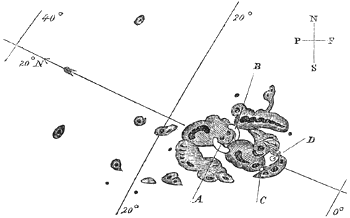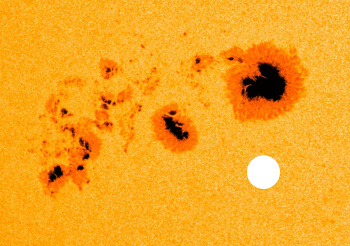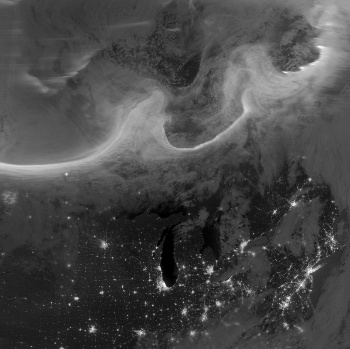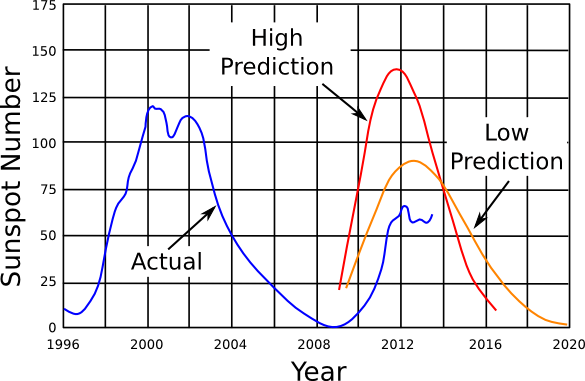Quiet Sun?
February 5, 2014
Scientists like regularity. If something is regular, it's easy to make
predictions and frame a
mathematical model. The
Sun is predictable in having a
solar cycle of about eleven years.
Sunspots wax and wane with regularity over this period, one eleven year cycle after another.
Amidst that regularity is the fact that each solar cycle has its own personality, some periods having more sunspots. The
Sun had a quiet phase at the latter half of the
17th century when there were very few sunspots. I wrote about this
Maunder Minimum, which occurred from 1650-1700, in a
previous article (Space Weather, May 23, 2012).
The Maunder Minimum coincided with a global cooling known as the Little Ice Age. Such a cooling occurred also during the less dramatic Spörer Minimum between 1460 and 1550. As underscored by recent controversy, there are many factors that determine Earth's temperature, and a causal relationship hasn't been established between a quiet sun and cooler weather.
One possible connection could be the ultraviolet radiation associated with an active Sun. Ultraviolet is the most energetic light radiation, so the Sun will heat Earth's atmosphere to a greater extent when active, and to a lesser extent when quiet. The Sun has been extremely quiet during its current cycle, especially now, when it should be at peak activity. The Sun is behaving as it did in the early years of the Maunder Minimum.[1] It's just anecdotal evidence, easily discounted, but it's been really cold this winter in New Jersey.

Sunspots on September 1, 1859, as drawn by English astronomer, Richard Carrington
The Carrington Event was a massive solar storm centered around September 1, 1859.
(Via Wikimedia Commons))
Michael Lockwood, a professor of space environment physics at the University of Reading, is quoted by the BBC as saying, "We estimate that within about 40 years or so there is a 10% to 20% - nearer 20% - probability that we'll be back in Maunder Minimum conditions."[1] Lockwood explains, also, why a little ultraviolet would have a large affect on climate in Northern mid-latitudes. This would influence the course of the jet stream, which is prone to meander.[1]
The Intergovernmental Panel on Climate Change has concluded that solar variation has a very small affect on Earth's climate, as opposed to regional variation as noted above.[1] Direct satellite measurement of solar forcing showed a decrease of just –0.04 W/m2 from 1986 to 2008.
The Sun has been fairly quiet at this peak in its current cycle, but it hasn't been completely inactive. As seen in the figure, an enormous sunspot group, designated AR1944, appeared on New Year's Day, January 1, 2014.[2] The group was seven Earth diameters wide, and its largest member was about two Earth diameters wide.[2] This particular sunspot was one of the largest to appear in about a decade.

Sunspot group, AR1944, as imaged in mid-January by the NASA Solar Dynamics Observatory. It's size can be compared with the size of the Earth, as shown by the white spot
(NASA/SDO image, modified.)
A class X1.2 solar flare erupted from an area, A1943, near this sunspot group, on Jan. 17, 2014, peaking at 1:32 PM EST. X-class flares are the most intense flares.[3] About a week prior to this flare, on Jan. 9, 2014, at 2:32 PM EST, a coronal mass ejection (CME) reached the Earth after its emission on January seventh.[4] CMEs will produce auroras when their charged particles interact with Earth's magnetosphere to cause excitation of atoms in the upper atmosphere.

A spectacular space-based observation of an aurora.
This October 8, 2012, aurora was observed at night over the Quebec and Ontario provinces of Canada by the Visible Infrared Imaging Radiometer Suite of the Suomi National Polar-orbiting Partnership (Suomi NPP) satellite.
(NASA/Suomi NPP image.)
Aside from these notable recent blips, just how quiet has the Sun been during this cycle, known as Solar Cycle 24? The graph, below, summarizes its activity. Not only is the Sun less active than during the previous cycle, it's less active than the lowest prediction, made in April, 2007.

Lower than expected. This graph of actual and predicted sunspot numbers for Solar Cycle 24 shows that the activity is much less than the previous cycle, and it is less than the lowest prediction for its cycle. (NOAA data, solar cycle and April, 2007, predictions, graphed using Inkscape.)
The US National Oceanic and Atmospheric Administration maintains a web site, http://spaceweather.gov, containing real-time information on solar status and information on space weather.[3]
References:
- Rebecca Morelle, "Is our Sun falling silent?," BBC World Service, January 17, 2014.
- Karen C. Fox, "NASA's SDO Sees Giant January Sunspots," NASA Goddard Space Flight Center Press Release, January 7, 2014.
- Karen C. Fox, "Sun Unleashes First X-class Flare of 2014," NASA Goddard Space Flight Center Press Release, January 7, 2014.
- Karen C. Fox, "Weak CME Arrives and Sparks Aurora," NASA Goddard Space Flight Center Press Release, January 14, 2014.
- Movie of the January 7, 2014, X-class solar flare. NASA Solar Dynamics Observatory images at 1600 Angstrom wavelength, looping four times. (NASA/SDO/Goddard).
- Solar Storm and Space Weather - Frequently Asked Questions, NASA web site.
Permanent Link to this article
Linked Keywords: Scientist; prediction; mathematical model; Sun; solar cycle; sunspot; 17th century; Maunder Minimum; Little Ice Age; Spörer Minimum; global warming controversy; Earth's temperature; causality; causal relationship; weather; ultraviolet; electromagnetic radiation; Earth; atmosphere; anecdotal evidence; winter; New Jersey; English people; astronomer; Richard Christopher Carrington; solar storm of 1859; Carrington Event; geomagnetic storm; solar storm; Wikimedia Commons; Michael Lockwood; professor; space environment physics; University of Reading; BBC; climate; temperate climate; Northern mid-latitudes; jet stream; Intergovernmental Panel on Climate Change; remote sensing; direct satellite measurement; radiative forcing; solar forcing; insolation; W/m2; New Year's Day; Earth diameter; decade; NASA; Solar Dynamics Observatory; class X1.2; solar flare; coronal mass ejection; aurora; charged particle; magnetosphere; near space; upper atmosphere; Quebec; Ontario; province; Canada; Visible Infrared Imaging Radiometer Suite; Suomi National Polar-orbiting Partnership; Solar Cycle 24; Wolf number; sunspot number; National Oceanic and Atmospheric Administration; NOAA; Inkscape; space weather.